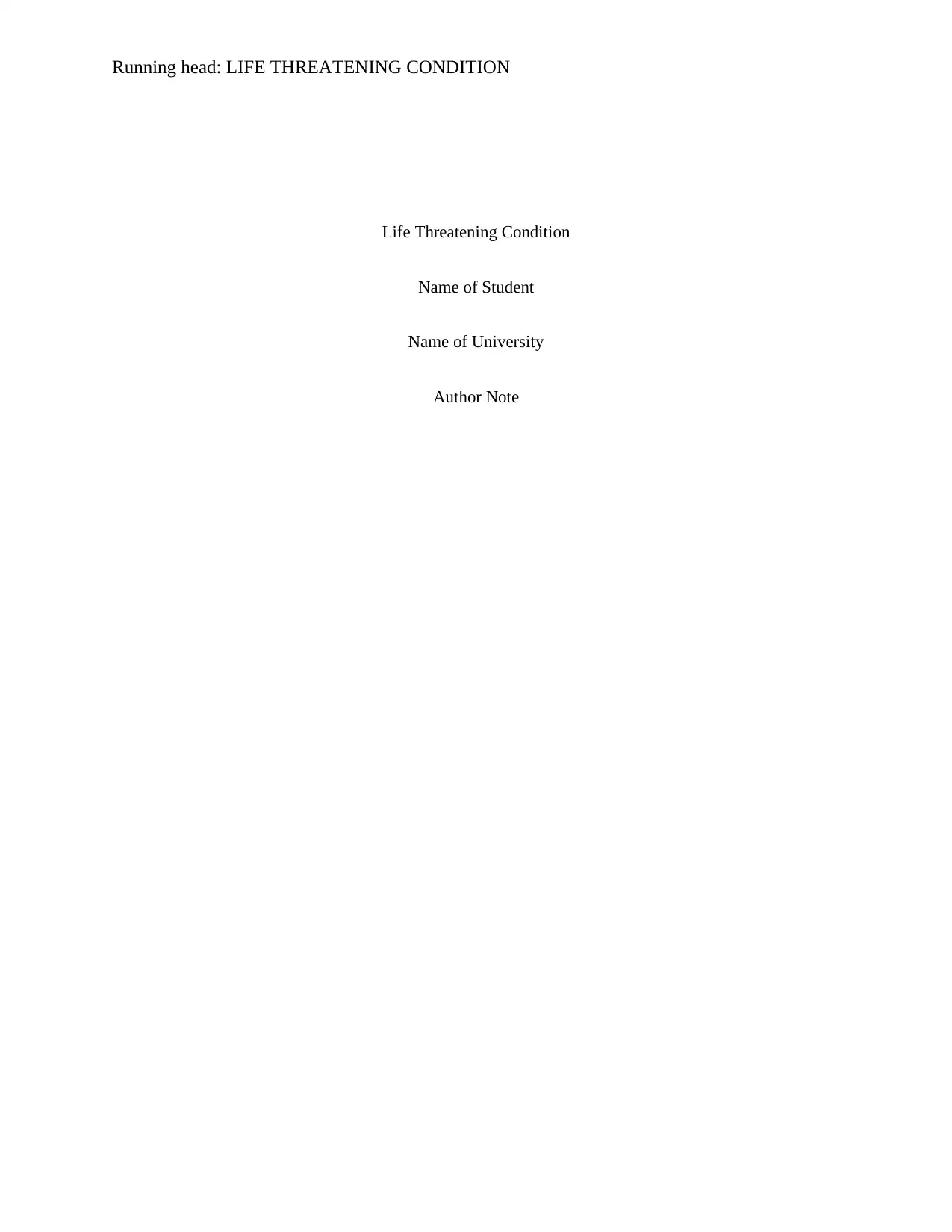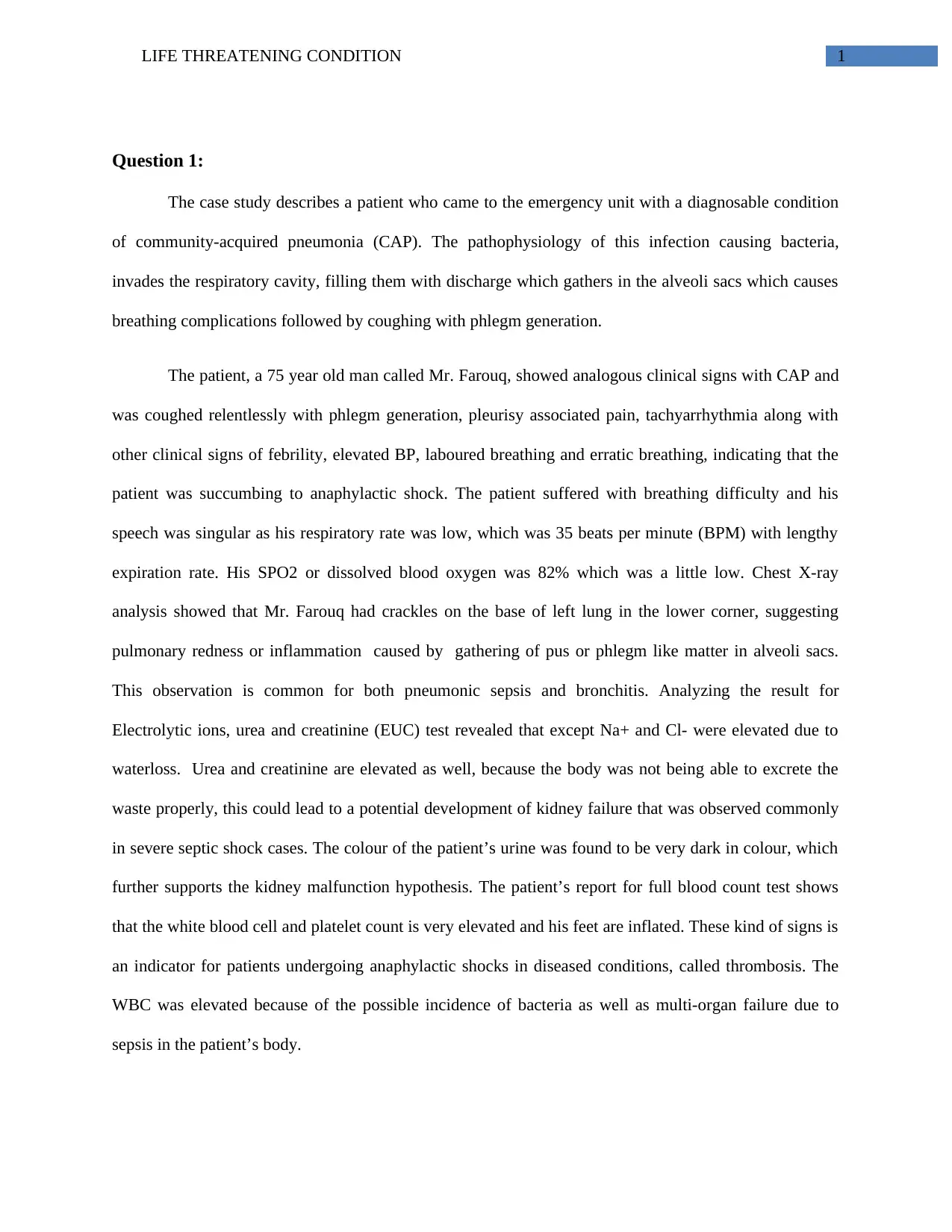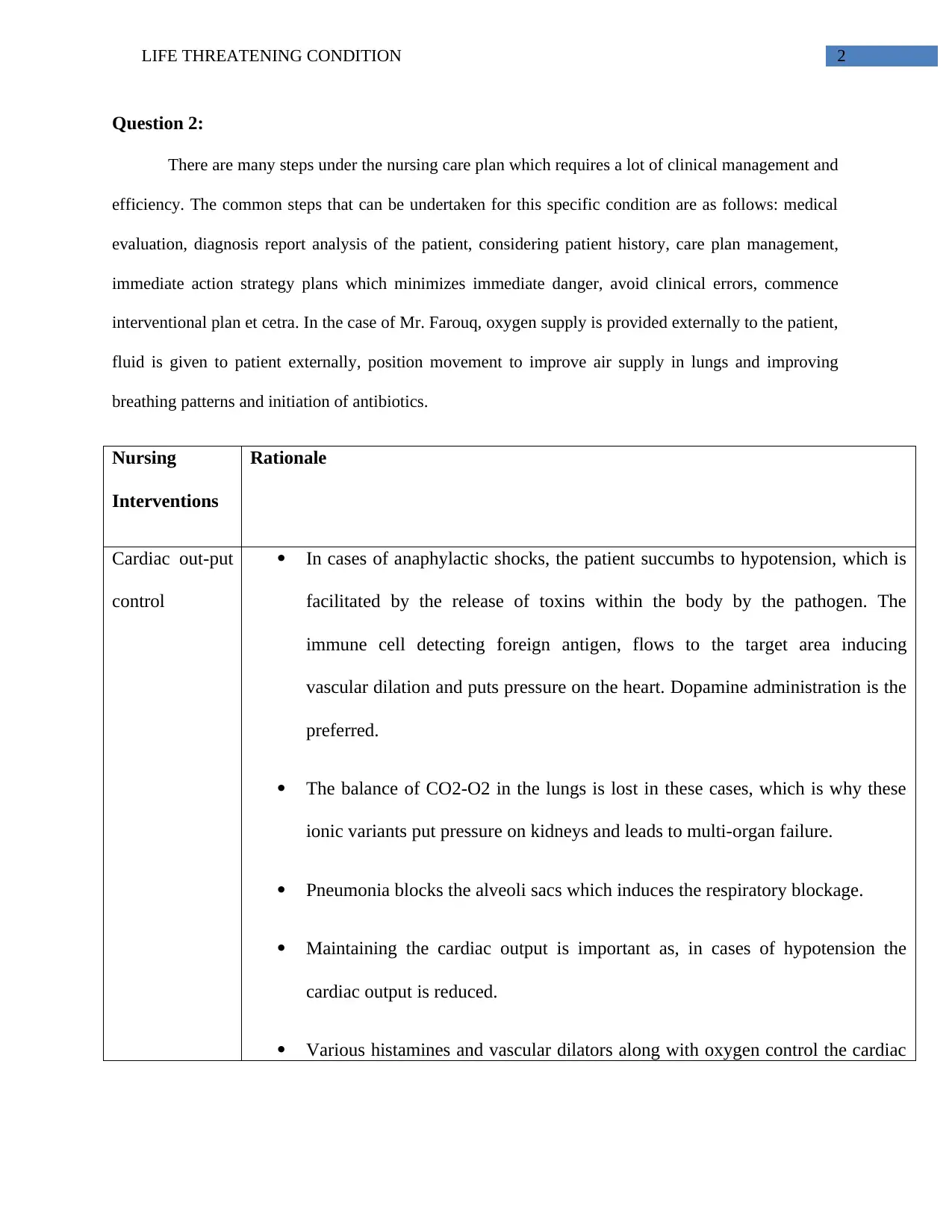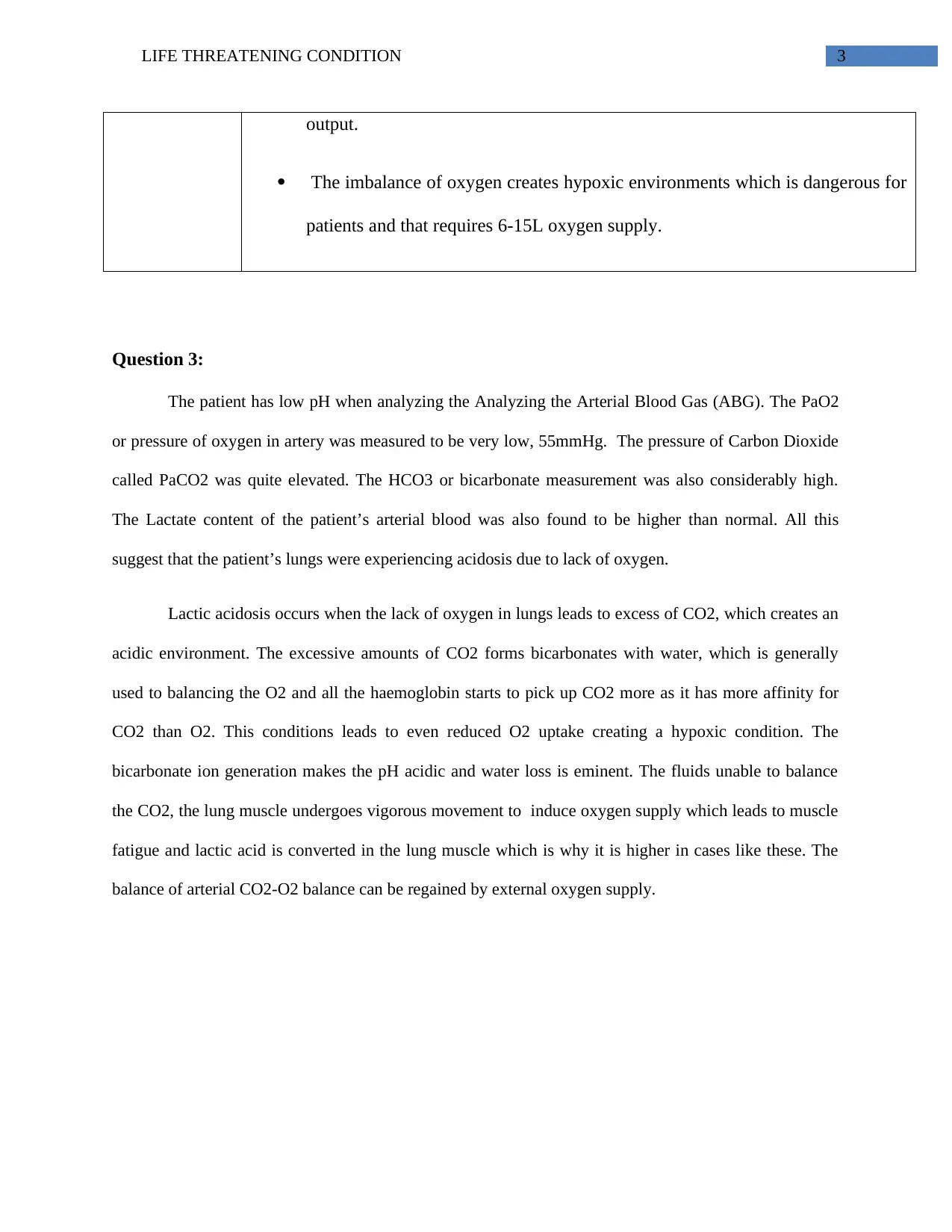Case Study: Acute Life Threatening Conditions - Community Pneumonia
VerifiedAdded on 2023/06/14
|4
|918
|314
Case Study
AI Summary
This case study examines a 75-year-old male patient, Mr. Farouq, who presents to the emergency unit with symptoms indicative of community-acquired pneumonia (CAP). The analysis covers the pathophysiology of CAP, detailing how the infection leads to breathing complications and phlegm generation. Mr. Farouq's clinical signs, including coughing, pleurisy, tachyarrhythmia, and laboured breathing, are assessed alongside diagnostic results such as chest X-rays and electrolytic ion tests. The study further explores the nursing care plan, emphasizing immediate action strategies, oxygen supply, and fluid administration to improve the patient's condition. An analysis of the patient's Arterial Blood Gas (ABG) reveals acidosis due to a lack of oxygen, leading to potential lactic acidosis. The report concludes by highlighting the importance of external oxygen supply in regaining arterial CO2-O2 balance.

Running head: LIFE THREATENING CONDITION
Life Threatening Condition
Name of Student
Name of University
Author Note
Life Threatening Condition
Name of Student
Name of University
Author Note
Paraphrase This Document
Need a fresh take? Get an instant paraphrase of this document with our AI Paraphraser

LIFE THREATENING CONDITION 1
Question 1:
The case study describes a patient who came to the emergency unit with a diagnosable condition
of community-acquired pneumonia (CAP). The pathophysiology of this infection causing bacteria,
invades the respiratory cavity, filling them with discharge which gathers in the alveoli sacs which causes
breathing complications followed by coughing with phlegm generation.
The patient, a 75 year old man called Mr. Farouq, showed analogous clinical signs with CAP and
was coughed relentlessly with phlegm generation, pleurisy associated pain, tachyarrhythmia along with
other clinical signs of febrility, elevated BP, laboured breathing and erratic breathing, indicating that the
patient was succumbing to anaphylactic shock. The patient suffered with breathing difficulty and his
speech was singular as his respiratory rate was low, which was 35 beats per minute (BPM) with lengthy
expiration rate. His SPO2 or dissolved blood oxygen was 82% which was a little low. Chest X-ray
analysis showed that Mr. Farouq had crackles on the base of left lung in the lower corner, suggesting
pulmonary redness or inflammation caused by gathering of pus or phlegm like matter in alveoli sacs.
This observation is common for both pneumonic sepsis and bronchitis. Analyzing the result for
Electrolytic ions, urea and creatinine (EUC) test revealed that except Na+ and Cl- were elevated due to
waterloss. Urea and creatinine are elevated as well, because the body was not being able to excrete the
waste properly, this could lead to a potential development of kidney failure that was observed commonly
in severe septic shock cases. The colour of the patient’s urine was found to be very dark in colour, which
further supports the kidney malfunction hypothesis. The patient’s report for full blood count test shows
that the white blood cell and platelet count is very elevated and his feet are inflated. These kind of signs is
an indicator for patients undergoing anaphylactic shocks in diseased conditions, called thrombosis. The
WBC was elevated because of the possible incidence of bacteria as well as multi-organ failure due to
sepsis in the patient’s body.
Question 1:
The case study describes a patient who came to the emergency unit with a diagnosable condition
of community-acquired pneumonia (CAP). The pathophysiology of this infection causing bacteria,
invades the respiratory cavity, filling them with discharge which gathers in the alveoli sacs which causes
breathing complications followed by coughing with phlegm generation.
The patient, a 75 year old man called Mr. Farouq, showed analogous clinical signs with CAP and
was coughed relentlessly with phlegm generation, pleurisy associated pain, tachyarrhythmia along with
other clinical signs of febrility, elevated BP, laboured breathing and erratic breathing, indicating that the
patient was succumbing to anaphylactic shock. The patient suffered with breathing difficulty and his
speech was singular as his respiratory rate was low, which was 35 beats per minute (BPM) with lengthy
expiration rate. His SPO2 or dissolved blood oxygen was 82% which was a little low. Chest X-ray
analysis showed that Mr. Farouq had crackles on the base of left lung in the lower corner, suggesting
pulmonary redness or inflammation caused by gathering of pus or phlegm like matter in alveoli sacs.
This observation is common for both pneumonic sepsis and bronchitis. Analyzing the result for
Electrolytic ions, urea and creatinine (EUC) test revealed that except Na+ and Cl- were elevated due to
waterloss. Urea and creatinine are elevated as well, because the body was not being able to excrete the
waste properly, this could lead to a potential development of kidney failure that was observed commonly
in severe septic shock cases. The colour of the patient’s urine was found to be very dark in colour, which
further supports the kidney malfunction hypothesis. The patient’s report for full blood count test shows
that the white blood cell and platelet count is very elevated and his feet are inflated. These kind of signs is
an indicator for patients undergoing anaphylactic shocks in diseased conditions, called thrombosis. The
WBC was elevated because of the possible incidence of bacteria as well as multi-organ failure due to
sepsis in the patient’s body.

LIFE THREATENING CONDITION 2
Question 2:
There are many steps under the nursing care plan which requires a lot of clinical management and
efficiency. The common steps that can be undertaken for this specific condition are as follows: medical
evaluation, diagnosis report analysis of the patient, considering patient history, care plan management,
immediate action strategy plans which minimizes immediate danger, avoid clinical errors, commence
interventional plan et cetra. In the case of Mr. Farouq, oxygen supply is provided externally to the patient,
fluid is given to patient externally, position movement to improve air supply in lungs and improving
breathing patterns and initiation of antibiotics.
Nursing
Interventions
Rationale
Cardiac out-put
control
In cases of anaphylactic shocks, the patient succumbs to hypotension, which is
facilitated by the release of toxins within the body by the pathogen. The
immune cell detecting foreign antigen, flows to the target area inducing
vascular dilation and puts pressure on the heart. Dopamine administration is the
preferred.
The balance of CO2-O2 in the lungs is lost in these cases, which is why these
ionic variants put pressure on kidneys and leads to multi-organ failure.
Pneumonia blocks the alveoli sacs which induces the respiratory blockage.
Maintaining the cardiac output is important as, in cases of hypotension the
cardiac output is reduced.
Various histamines and vascular dilators along with oxygen control the cardiac
Question 2:
There are many steps under the nursing care plan which requires a lot of clinical management and
efficiency. The common steps that can be undertaken for this specific condition are as follows: medical
evaluation, diagnosis report analysis of the patient, considering patient history, care plan management,
immediate action strategy plans which minimizes immediate danger, avoid clinical errors, commence
interventional plan et cetra. In the case of Mr. Farouq, oxygen supply is provided externally to the patient,
fluid is given to patient externally, position movement to improve air supply in lungs and improving
breathing patterns and initiation of antibiotics.
Nursing
Interventions
Rationale
Cardiac out-put
control
In cases of anaphylactic shocks, the patient succumbs to hypotension, which is
facilitated by the release of toxins within the body by the pathogen. The
immune cell detecting foreign antigen, flows to the target area inducing
vascular dilation and puts pressure on the heart. Dopamine administration is the
preferred.
The balance of CO2-O2 in the lungs is lost in these cases, which is why these
ionic variants put pressure on kidneys and leads to multi-organ failure.
Pneumonia blocks the alveoli sacs which induces the respiratory blockage.
Maintaining the cardiac output is important as, in cases of hypotension the
cardiac output is reduced.
Various histamines and vascular dilators along with oxygen control the cardiac
⊘ This is a preview!⊘
Do you want full access?
Subscribe today to unlock all pages.

Trusted by 1+ million students worldwide

LIFE THREATENING CONDITION 3
output.
The imbalance of oxygen creates hypoxic environments which is dangerous for
patients and that requires 6-15L oxygen supply.
Question 3:
The patient has low pH when analyzing the Analyzing the Arterial Blood Gas (ABG). The PaO2
or pressure of oxygen in artery was measured to be very low, 55mmHg. The pressure of Carbon Dioxide
called PaCO2 was quite elevated. The HCO3 or bicarbonate measurement was also considerably high.
The Lactate content of the patient’s arterial blood was also found to be higher than normal. All this
suggest that the patient’s lungs were experiencing acidosis due to lack of oxygen.
Lactic acidosis occurs when the lack of oxygen in lungs leads to excess of CO2, which creates an
acidic environment. The excessive amounts of CO2 forms bicarbonates with water, which is generally
used to balancing the O2 and all the haemoglobin starts to pick up CO2 more as it has more affinity for
CO2 than O2. This conditions leads to even reduced O2 uptake creating a hypoxic condition. The
bicarbonate ion generation makes the pH acidic and water loss is eminent. The fluids unable to balance
the CO2, the lung muscle undergoes vigorous movement to induce oxygen supply which leads to muscle
fatigue and lactic acid is converted in the lung muscle which is why it is higher in cases like these. The
balance of arterial CO2-O2 balance can be regained by external oxygen supply.
output.
The imbalance of oxygen creates hypoxic environments which is dangerous for
patients and that requires 6-15L oxygen supply.
Question 3:
The patient has low pH when analyzing the Analyzing the Arterial Blood Gas (ABG). The PaO2
or pressure of oxygen in artery was measured to be very low, 55mmHg. The pressure of Carbon Dioxide
called PaCO2 was quite elevated. The HCO3 or bicarbonate measurement was also considerably high.
The Lactate content of the patient’s arterial blood was also found to be higher than normal. All this
suggest that the patient’s lungs were experiencing acidosis due to lack of oxygen.
Lactic acidosis occurs when the lack of oxygen in lungs leads to excess of CO2, which creates an
acidic environment. The excessive amounts of CO2 forms bicarbonates with water, which is generally
used to balancing the O2 and all the haemoglobin starts to pick up CO2 more as it has more affinity for
CO2 than O2. This conditions leads to even reduced O2 uptake creating a hypoxic condition. The
bicarbonate ion generation makes the pH acidic and water loss is eminent. The fluids unable to balance
the CO2, the lung muscle undergoes vigorous movement to induce oxygen supply which leads to muscle
fatigue and lactic acid is converted in the lung muscle which is why it is higher in cases like these. The
balance of arterial CO2-O2 balance can be regained by external oxygen supply.
1 out of 4
Related Documents
Your All-in-One AI-Powered Toolkit for Academic Success.
+13062052269
info@desklib.com
Available 24*7 on WhatsApp / Email
![[object Object]](/_next/static/media/star-bottom.7253800d.svg)
Unlock your academic potential
Copyright © 2020–2025 A2Z Services. All Rights Reserved. Developed and managed by ZUCOL.





